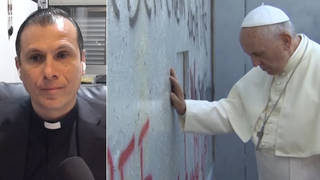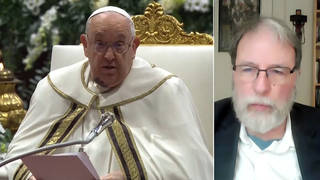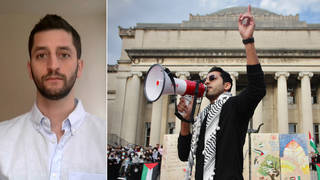
Topics
Guests
- Bruce Childsprotest organizer in Sydney, Australia.
- Andrew Burginorganizer with the British group Stop the War, speaking from a London demonstration.
- Matt BradleyWPFW reporter, speaking from Washington, D.C., where protesters blocked a main bridge.
- Jenn Carrorganizer with United for Peace and Justice.
More than 500 communities throughout the U.S. are organizing protests for today. Activists are calling for nationwide walkouts, strikes and protests. Yesterday, dozens of people were arrested in Washington while staging antiwar protests in the nation’s capital. Over 200 demonstrators marched from a park near the White House to War Secretary Donald Rumsfeld’s house in northwest Washington. In Boston, police arrested 36 people in two antiwar protests at a federal building and outside the Boston Stock Exchange. During a midday march to the United Nations in New York, 45 antiwar demonstrators were taken into custody and charged with disorderly conduct.
And Reuters reports that a wave of antiwar protests rolled across Europe and the Middle East after the opening salvos of the war against Iraq. Barely three hours after the first U.S. missiles struck Baghdad, a crowd that organizers put at 40,000 and which police said numbered “tens of thousands” brought Australia’s second-largest city, Melbourne, to a standstill. In Germany, 50,000 school students marched in Berlin. In Britain, activists are calling on workers to stage a mass walkout from offices and colleges around the country.
Transcript
AMY GOODMAN: We now turn to the protests that are taking place in this country and around the world. A wave of antiwar protests began to roll across Europe and the Middle East today, after the opening salvos of the war against Iraq sparked angry demonstrations in Asia and Australia. Barely three hours after the first U.S. missiles struck Baghdad, a crowd that organizers put at 40,000 and which police said numbered “tens of thousands” brought Australia’s second-largest city, Melbourne, to a standstill. Sydney also saw tens of thousands of people.
Bruce Childs is on the line with us right now. He helped organize the antiwar protest in Sydney.
Welcome to Democracy Now!, Bruce.
BRUCE CHILDS: Thanks very much.
AMY GOODMAN: Can you tell us what happened?
BRUCE CHILDS: Well, we had the three hours’ notice, and we were very happy that 20,000 people turned up at such short notice, because we’re preparing for a major rally this Sunday, and we see this rally just as a preparation for Sunday. One month ago, we had 300,000 people walk through the streets of Sydney protesting the war, so we’re very confident we will get a very good crowd on Sunday. We were very heartened by the number of people who could turn out at such short notice today.
AMY GOODMAN: Bruce Childs in Sydney, Australia. And those are just some of the protests that we’re hearing about.
In Germany, 50,000 school students marched from Berlin’s main plaza, Alexanderplatz, past the guarded U.S. Embassy and through the Brandenburg Gate. Bigger demonstrations planned later today in the capital of Germany and dozens of other towns and cities. Some 5,000 students were also demonstrating in Cologne.
In France, the most vocal Western opponent of the war, a string of organizations plan to rally outside the U.S. Embassy in Paris. The mission was barricaded off to the public by midmorning, surrounded with 15 to 20 police vans, a water cannon and scores of police, some with riot shields.
In Italy, antiwar activists and labor unions staged demonstrations and downed their tools. Protesters in Milan held a vigil in front of the city’s cathedral, while in Venice and Rome, groups of hundreds gathered for spontaneous sit-ins. Thousands more are expected to take part in a march in the U.S. Embassy in Rome in the afternoon. Public sector workers declared a daylong strike, while Italy’s three biggest unions, with a combined 11 million members, said they would strike for two hours to protest against the attacks.
In Greece, where there’s bitter public and government opposition to a U.S. invasion of Iraq, the center of Athens was turned into a huge protest arena. Nearly 10,000 people, including many schoolchildren, gathered to march to the U.S. Embassy. Greek police rushed reinforcements to the embassy to protect it.
You’re listening to mass protests around the world, and we’re going to talk about the protests in New York in just a minute. We’ll be breaking now for stations to identify themselves. You’re listening to Democracy Now! I’m Amy Goodman, with Jeremy Scahill. Stay with us.
[break]
AMY GOODMAN: You are listening to Democracy Now! This is The War and Peace Report. I’m Amy Goodman, here with Jeremy Scahill. And we are going to go to the protests in Britain and in the United States. Jeremy, what about what we’re seeing in Iraq right now? Jeremy Scahill, Democracy Now! correspondent, who’s just returned from Baghdad.
JEREY SCAHILL: I think it’s very interesting how come the Iraqi regime appears to be right now. You know, we’ve seen Mohammed al-Sahhaf, the Iraqi information minister, clearly voicing outrage at the attacks that have begun against Iraq. But they still seem very much in control of the situation.
And what’s interesting is that we, over the last few weeks, saw signs of Iraq preparing to essentially impose martial law at the onset of a bombing, and even Iraqi officials said that, you know, a day before an attack would happen, that there would most likely be army control in the streets, that there would be three circles or spheres of movement that you would need passes to move around. They had deployed special units of police on intersections throughout Baghdad, putting sandbags on overpasses and positioning these camouflaged special forces around the city. We also saw the Iraqis digging these huge holes, that even Iraqi officials were saying were going to be filled with oil and then torched at the onset of bombing to try to create a very thick cloud of black smoke over the city of Baghdad. Also, we heard reports that they would dump oil into the Tigris River and set it ablaze, because the Tigris goes right around the main centers of power, and so they were trying to — the idea was to try to hide them from the laser-guided munitions. But we haven’t seen any of that. Iraq has not imposed martial law as of now. They haven’t taken any of those steps to cover Baghdad in a black cloud of smoke.
And as for these reports that the U.S. has bombed the TV and radio station in Iraq, we understand, from our sources in Baghdad, just talking to them today, that the Iraqi radio and TV is going on as normal. If they had hit that building, we would know it, because it’s right across the street from the Ministry of Information, where all of the journalists are housed. And finally, what I find incredible, too, is that Iraq has not, as we can see right now, begun expelling journalists at all. And we understand that they, in fact, were taking journalists to sites today. And I think it’s to Iraq’s advantage to handle the situation as they are right now. If they expel the journalists, they lose their only chance of communicating to the world. And the Gulf War proved that, and I think that they’ve changed their strategy as of now.
AMY GOODMAN: I think it’s also very important to point out that — when we say, in the beginning of the news headlines, the U.S. government said that Iraq had launched missiles, missiles against Kuwait, I think it’s very important to point out that this is what we know from the U.S. government.
JEREMY SCAHILL: Right. And I also think, you know, we can learn a lot of lessons from the way that the United States has conducted itself in other bombing campaigns on the propaganda front — Afghanistan, Yugoslavia, as well. I mean, the Pentagon is saying Iraq launched these Scud missiles in Kuwait. And it’s interesting. When you watch the reports from these so-called embedded journalists — you know, they’re the “in bed” journalists, and it’s a very appropriate term, because they’re totally embedded with the Pentagon — I think —
AMY GOODMAN: It’s hard to even distinguish what they’re saying. So often on CNN now, they say, “And now we go to our reporter embedded with the Marines.” I’m trying to hear that last ED. But we do have Andrew Burgin on the line, who’s with the Stop the War Coalition in London right now. Andrew, can you tell us what’s happening there?
ANDREW BURGIN: What’s happening here, I mean, is just tens of thousands of people have come out in London. They’re blocking streets. The whole area around our Parliament is blocked. There are many thousand school students here, university students. People have left their workplaces. Other parts of London are blocked, as well. And together with that, people are doing this up and down the country. And at 6:00 tonight our time, we’ll be having a further national protest.
AMY GOODMAN: And we’re going to go right now from London to Washington, D.C. Matt Bradley, WPFW Pacifica reporter. Where are you standing right now, Matt?
MATT BRADLEY: Hello, Amy. I’m at the end of the Key Bridge in Georgetown, Washington, D.C., where at least a hundred activists have just finished blocking the Key Bridge for several minutes in the midst of morning rush hour traffic. Hello? Amy?
AMY GOODMAN: Yes. And how many people are there? What are they saying?
MATT BRADLEY: Well, there are at least a hundred people, and it is a combination of Critical Mass, antiwar protests. So the main chant has been “Arrest Bush, not me!” as they block off — as they blocked off the bridge. And they’re actually in a short standoff, but now traffic is flowing outbound, out of Washington, again, on the bridge, and demonstrators are being allowed to leave single file. But they disrupted traffic for several minutes this morning.
AMY GOODMAN: And again, where are you, Matt Bradley, in Washington?
MATT BRADLEY: I am at the end of the Key Bridge in the Georgetown neighborhood in Washington, D.C., between Georgetown and Rosslyn, Virginia.
AMY GOODMAN: Which brings us to Jenn Carr to give us a summary of what’s going on around the country. Jenn Carr, also in Washington, D.C., welcome to Democracy Now!
JENN CARR: Thank you, Amy. Right now all around the country there is a rolling wave of protests that’s happening. There’s over 500, and I’m sure it’s just building by the moment. Yesterday, the amount of protests that got posted to the United for Peace website, it grew by about 400 protests, literally, over the course of a day. So I wouldn’t be surprised if you see it continue to grow through today. And people should go to www.unitedforpeace.org to find out about protests that are happening all across the United States.
For instance, in L.A., people are going to Henry Waxman’s office to hold Congress accountable for turning over the authority to George Bush. There’s an emergency march at the federal building. San Francisco, they’re planning a — similar to what we were just talking about, no business as usual, nonviolent direct action to stop the war. Here in D.C., as you heard, that’s happening, as well, as well as a permitted rally later on and another march that will happen. New York, there must be — I don’t know how many protests are happening in the whole state of New York, but at ground zero there’s a peace vigil. There’s a convergence on Times Square at 5:00. People are doing an interfaith prayer service at St. Francis Xavier Church. Chicago, they’re going to the federal buildings, and then they’re following up again the next day. Houston, I mean, all over Texas — this is Texas, and there must be, you know, at least a dozen protests that are happening, a big one at Hermann Park in Houston, a rally. Indianapolis, Indiana, 24 consumer — 24-hour consumer boycott. You know, people are doing creative stuff. There’s rallies, vigils, walks. People are walking out of work. They’re doing no business as usual, getting in the streets and blocking traffic. They’re holding vigils. They’re doing rallies.
Students all across the country and as well as their professors and other people in the administrations, are walking off campuses. The University of North Carolina has a campus walkout planned, as well as hundreds of other campuses across the country. And to find out more about campus organizing, there are two large campus networks of students, coalitions, that you can find if you go to www.antiwarnetwork.org, or you can go to www.nyspc.net. That’s the National Youth and Student Peace Coalition. These are great places for students to find out and plug into this huge, growing student movement.
National, Tennessee, you know, they’re at the federal buildings in Tennessee. West Virginia, there’s a peace vigil. Albuquerque, New Mexico, they’re at the Kirtland Air Force Base with the “no blood for oil” message. All over the country, it’s just an amazing rolling wave, Amy, an outpouring of dissent and outcry for what our administration is doing and the role that our government is going to put us into in the international community and in the world. Americans do not want to be seen as this arrogant force in the world.
AMY GOODMAN: Jenn Carr, speaking to us from Washington, with United for Peace, talking about just some of the protests that are taking place around the country, also with Peace Action, I want to thank you for being with us.













Media Options